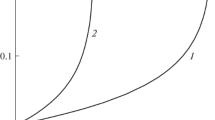Abstract
In the present work, interest is centered on the theory of fracture and practical approaches to reliability estimation of unidirectional composite materials which are based on it. Fracture mechanics is considered not as a theory of macrocracks but as mechanics of fracture mechanisms of the composites with allowance made for probability estimation. A model of composite material with fibers eliminated from the carrying scheme and parameters specific to the stress-strain-damage state (SSDS) was considered. According to the model, during loading, self-accelerated energy rise is accounted for by structural damages growth — the catastrophe takes place. The model allows us to calculate the critical stress. The composites redistribute forces from overloading zones to neighboring ones by microstructural deformations and damages. It is the effect of reservation of carrying ability. Due to this effect, low-value probability of fracture is sufficiently less for the composite than for homogeneous materials. The approach allows us to evaluate the reliability function for both static loading and fatigue.
Similar content being viewed by others
References
G. Z. Voyaljis (ed.), Damage in Composite Materials, Elsevier (1993).
L. N. Phillips (ed.), Design with Advanced Composite Materials, Design Council, Springer (1989).
A. Kelly and N. H. Macmillan, Strong Solids, Oxford Science Publications (1986).
T. Fujii and M. Sako, Fracture Mechanics of Composite Materials [Russian translation], Mir, Moscow (1988).
N. B. Romalis and V. P. Tamuzh, Fracture of Structurally Inhomogeneous Bodies [in Russian], Zinatne, Riga (1989).
A. S. Ovchinskii, Fracture Processes in Composite Materials: Computer Simulation of Micro- and Macromechanisms [in Russian], Nauka, Moscow (1988).
H. O. Madsen, S. Krenk, and N. C. Lind, Methods of Structural Safety, Prentice-Hall (1986).
V. V. Bolotin, Useful Life of Machines and Constructions [in Russian], Mashinostroenie, Moscow (1990).
I. I. Koksharov, “Prediction of mechanical properties of unidirectional composite material with brittle fibers under tension”, Zavoid. Lab., No. 1, 46–49 (1990).
N. A. Makhutov and I. I. Koksharov, “Model representations of the fracture of unidirectional composite material with brittle fibers under tension”, Mekh. Kompozit. Mater., No. 5, 804–811 (1991).
R. Gilmore, Catastrophe Theory of Scientists and Engineers, Wiley (1981).
T. Poston and I. N. Stewart, Catastrophe Theory and Its Applications, Pitman (1978).
G. A. Korn and T. M. Korn, Mathermatical Handbook for Scientists and Engineers, McGraw-Hill (1968).
P. C. Paris, M. P. Gomez, and W. E. Anderson, “A rational analytic theory of fatigue”, Trend Eng., No. 13, 9–14 (1961).
Additional information
Computing Center of the Russian Academy of Sciences, Krasnoyarsk, Russia. Published in Mekhanika Kompozitnykh Materialov, Vol. 32, No. 4, pp. 539–548, July–August, 1996.
Rights and permissions
About this article
Cite this article
Koksharov, I.I. An estimation of reliability of unidirectional composites by catastrophe theory. Mech Compos Mater 32, 374–380 (1996). https://doi.org/10.1007/BF02254751
Received:
Issue Date:
DOI: https://doi.org/10.1007/BF02254751




